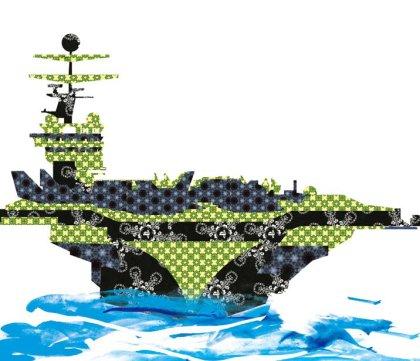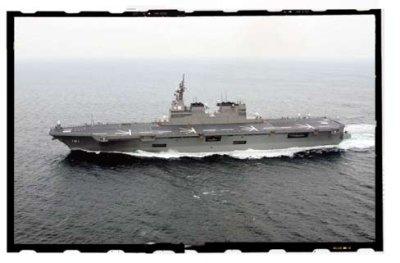Defense -- Crossing the Line
By Alex Calvo
Should Japan have aircraft carriers?
Aircraft carriers have been for the last few decades almost the exclusive domain of the United States, which has a total of 11, one of them based in Japan. Although a reduced number of countries, like France and Britain, or nearer to Japan, Thailand and India, have some of the smaller variety, Japan’s Maritime Self Defense Force doesn’t have any such ship, and their construction or purchase abroad is not included in current naval plans.

Of course, things have not always been like this, as anyone with a slight interest in World War II, or who has simply watched a few films set in the conflict, will remember that Japanese carriers ruled the waves … at least until the battle of Midway, where Japan’s Imperial Navy lost four.
The remaining ones, plus some hastily converted merchantmen and warships, were gradually sunk in the ensuing battles, until what had once been a proud force became a shadow of its former self, and Japan was left almost with no navy to speak of in the closing days of the war.
The surrender and occupation were supposed to give way to a “pacifist Japan,” a country which renounced war as a “sovereign right of the nation” and a “means of settling international disputes,” as stated in Article 9 of her new Constitution. However, the realities of the Cold War soon meant such noble aims had to be gradually discarded in order to add local units to American forces protecting the islands. Starting with a police reserve, Japan then added an army, navy and airforce, if only under the awkward name of the “Self-Defense Forces.” At this time it was decided that Japan’s navy would however be without “power-projection tools” such as carriers.
The importance of carriers to Japan
Despite the threat posed by modern missile systems, carriers are, and are expected to remain for the foreseeable future, the best way to project force far from one’s shores. They are small cities, complete with their own hospital, cinema or barbershop, and of course a wide array of aircraft plus all the support facilities (repair shops, ammunition magazines …) necessary for them to operate for extended periods of time. American carriers are all nuclear-powered, meaning that the length of their patrols is only limited by the need to provide crews with a rest plus the maintenance requirements of onboard systems. Food and other supplies can be provided by support ships.
 The MSDF Hyuga is classified as a carrier but some argue it is, in fact, a destroyer.
The MSDF Hyuga is classified as a carrier but some argue it is, in fact, a destroyer.
As mentioned, carriers are the best way to project air power anywhere around the world, including landlocked countries like Afghanistan, where much of allied aviation in service is aircraft-based. An aircraft means there is no need to reach agreements with foreign countries or build expensive facilities in order to support aircraft in faraway lands. Because of their primary use, carriers are often described as “offensive” weapons, that is, arms designed not to protect a country against invasion or foreign aggression, but rather to allow it to engage in “gunboat diplomacy” or intervene in any corner of the world.
Because of this, it has been traditionally considered that they had no place in Japan’s MSDF, which after all, is supposed, as its name implies, to be used only to defend Japan and not as part of the nation’s foreign policy. However, things have not been quite so simple.
First of all, the difference between defense and offense is not as clear cut as some would like it to be. When faced with a determined enemy, waiting to be struck might not be the best option, whereas preempting an attack can be construed as defense, even in accordance with international law.
Second, being an island nation, dependent on maritime trade for almost all her energy needs and her sizeable exports, means Japan can simply not afford to be vulnerable to a blockade at sea or encroachment of Japanese waters.
... the presence of nuclear powered Chinese carrier groups, specifically, if accompanied by a cut in the number of American ones, could leave Japan at the mercy of her bigger neighbor.
The changing maritime landscape in the Pacific
During the Cold War, and then leading up to the present day, there has been a division of labor between Washington and Tokyo, with the former protecting the long lines of communication linking Japan with key areas like the Persian Gulf (oil imports) or Europe and America (manufactured exports), while the latter concentrated on coastal defense. Due to this arrangement, and taking into account the mentioned constitutional restrictions on the Japanese Navy, there was no reason for Japan to consider buying carriers. However recent years have seen at least six important developments which might change Japanese views on the matter:
- The MSDF has grown to become one of the strongest navies of the world, second only to the U.S. Navy in the Pacific. Adding carriers to Japan’s list of military units seems a logical development.
- Japan’s eternal debate on the precise meaning of Article 9 has continued unabated, with increasingly stronger pressure to reform it or simply get rid of it. Many politicians and broad swathes of public opinion have come to view the use of force or at least the possibility to have recourse to it as acceptable and unavoidable in international relations, leading many commentators to speak of the coming “normalization” of Japan. Last year, the then chief of staff of the MSDF’s air force, General Tamogami, argued in a contest-winning essay that Japan should be able to enter into mutual defense treaties (the current agreement with the United States imposes a duty on America to assist Japan if attacked but not a reciprocal obligation on Japan) and although immediately dismissed by the government, it is clear he is not the only one to hold such views. On April 19, shortly after North Korea tested a missile under the guise of launching a satellite, former finance minister Shoichi Nakagawa stated Japan should develop nuclear weapons to deter the rogue state.
- North Korea remains a threat to countries in the region, above all Japan. Its nuclear and missile programs and aggressive rhetoric towards Tokyo have prompted speculation Japan might eventually decide to carry out a preemptive strike. In that case, aircraft carriers would give Japanese planners an extra degree of flexibility in suppressing North Korean air defense systems and getting at the selected targets.
- Increased pirate activity off the coast of Somalia has not only effectively threatened the transit of merchant ships in some of the world’s most crowded sea lanes, but also reminded all sea-faring nations that such danger is not the stuff of movies but a very real and serious threat. Japan’s contribution to international efforts against Somali piracy has consisted of two destroyers, plus two P-3C surveillance aircraft based in Djibouti. Although Japan has been able to secure the rights to have them based in the Middle-Eastern country, carriers would enable Japan to operate aircraft anywhere even without such agreements.
- The quiet but relentless ascent of China is being felt, among others, in the naval sphere, with China developing a true “blue water” navy. Beijing has dispatched warships to the Gulf of Aden and is developing anti-ship missiles, which some critics suggest could be deployed to prevent the United States from coming to the help of her allies in a crisis. It is also widely rumored that China has been seriously considering building its first carriers. Some observers expect China to soon begin work on four, with the first being launched in six years.
- Although the United States is expected to remain the dominant maritime power in the Pacific for the foreseeable future, and nobody is seriously questioning the alliance with Tokyo, Japan cannot take for granted the willingness or even the ability of America to intervene in a crisis with China. Recent cuts in America’s defense budget have cast doubts on the number of future nuclear carrier groups, which currently amount to eleven. Any reduction in this force coupled with the development of Chinese carriers could significantly alter the strategic equation in the Pacific.
Keeping up with China and protecting sea lanes.
All the above reasons are pushing Japan into the direction of developing her own nuclear carriers. Now it looks like this will happen at some point in the future. Although the main reason to do so may simply be to protect the sea lanes so vital to the country’s economy and security, the actual timetable is likely to be determined by Chinese plans. As long as China has no carriers, Japan can continue to slowly develop its maritime capacities, but the sight of Chinese carriers roaming the seas without them being followed by their Japanese counterparts, would be unpalatable to politicians in Tokyo. It was precisely Beijing’s decision to dispatch warships to Somalia which put an end to Tokyo’s painful debate on the matter. Furthermore, the presence of nuclear-powered Chinese carrier groups, specifically, if accompanied by a cut in the number of American ones, could leave Japan at the mercy of her bigger neighbor.
Some observers however are not convinced and see carriers as an expensive distraction in times of economic crisis. Even if the country can afford them, come Japanese are afraid the vessels might be perceived by other Asian countries as a sign of Japanese expansionism reminiscent of the pre-war period, sparking an arms race and sowing mistrust among neighbors.
Officially a destroyer … but it sure looks like a carrier
While the debate continues, not always in full view of the public, for all intents and purposes, Japan is already building carriers … helicopter carriers to be precise, although officially designated as destroyers. On March 18 this year, the biggest MSDF ship to date, called Hyuga, was launched. With a 195-meter-long flight deck, it can transport eleven helicopters, of which up to four can simultaneously land and take off. Although not designed to operate vertical takeoff airplanes, the Hyuga could be converted to accommodate them. In 2011, a sister ship of similar specifications will be built.
It therefore seems that although the return of Japanese carriers is by no means a foregone conclusion, the race has already started and is expected to heat up. As the saying goes “he who commands the sea, commands the land,” and there is no better way to do this than with these magnificent ships.
Alex Calvo is Professor of International Relations and International Law, European University in Barcelona (Spain); and Research and Teaching Fellow, OSCE Academy in Bishkek (Kyrgyz Republic).






Comments
AK (not verified)
December 11, 2012 - 15:00
Permalink
Is Hyuga an Aircraft Carrier?
My dear friend, you must be ignorant talking about this topic. Hyuga has been modified to hold choppers based on the model of destroyer. The world's most powerful Navies use destroyers. Not too many countries use the huge aircraft carriers now not just because they are too expensive to maintain, they are also slow, so they can be easy targets. Unlike the destroyers, they are more mobile and faster. The current technology trend does not require a long runway to launch powerful fighter planes. There are VTOL and STOL (Vertical Take Off and Landing / Short Take Off and Landing) aircrafts that can be housed in these small carriers. These carriers can carry Apache Attack Helicopters and Harrier Jets to launch air and ground attacks at sea. Not only that, these carriers are equipped with state-of-the-art missile system and defense mechanisms to protect itself from missile attacks from the enemy. So, is Hyuga an aircraft carrier capable of inflicting damage? YES IT IS. And it's a damn good one. Koreans use this too, not just Japan.